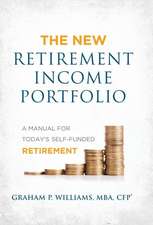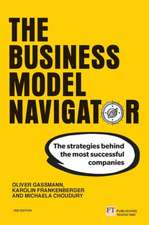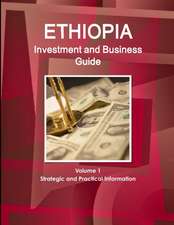Key Strategy Tools
Autor Vaughan Evansen Limba Engleză Paperback – 23 noi 2020
"This is a super useful toolkit for any strategist! Not onlydoes it explain each tool clearly and concisely but also gives guidance how andwhen to use them and what to be wary of. It will become an invaluable companion to any executive striving to develop a winning strategy for their organisation." Costas Markides, Professor of Strategy and Entrepreneurship, London Business School "I wish I had thought of the idea for this book. Or could havedone it so well! The selection of topics is excellent, the commentary astute, and the explanations simple and engaging. Perfect for reading on a plane or browsing at home."
Richard Koch, entrepreneur, co-founder L.E.K. Consulting and author, The80/20 Principle
"This is the new edition I longed for - I find it immensely helpful as a resource to offer Executive Education students every bit as much as MBAs. A very practical and delightfully pithy approach to strategy making, it offers a fabulous compendium of the major strategy tools, woven into a no-nonsense, step-by-step strategy process. It provides elegantly succinct explanations with enormously broad coverage to give a real 'map of the terrain'."
Marcus Alexander, Adjunct Professorof Strategy and Entrepreneurship, London Business School
"A really practical guide to strategy development. All the relevant tools are explained in detail, but highlighting the essential ones is a master stroke that will save endless hours!"
Adrian Beecroft, Chairman, Dawn Capital and former Senior Managing Partner, Apax Partners
"A comprehensive inventory of the tools and analytical frameworks of strategy. The key value of this bookis the guidance it offers on how to apply these tools - and this is rooted in Vaughan Evans' deep experience of working with them."
Robert M.Grant, ENI Professor of Strategic Management, Bocconi University, Milan and author of the market leading strategy textbook for business school students, Contemporary Strategic Analysis, now in its 10th edition
"Everything you need from a toolkit, comprehensive, practical and high added value."
Mike Garland, Chairman, C5 Holdings and former Partner and Head of Portfolio Group, Permira Advisers LLP
Preț: 248.73 lei
Nou
Puncte Express: 373
Preț estimativ în valută:
47.59€ • 49.70$ • 39.30£
47.59€ • 49.70$ • 39.30£
Carte disponibilă
Livrare economică 25 martie-08 aprilie
Livrare express 08-14 martie pentru 37.80 lei
Preluare comenzi: 021 569.72.76
Specificații
ISBN-13: 9781292328331
ISBN-10: 1292328339
Pagini: 416
Dimensiuni: 160 x 232 x 25 mm
Greutate: 0.63 kg
Ediția:2nd edition
Editura: Pearson Education
ISBN-10: 1292328339
Pagini: 416
Dimensiuni: 160 x 232 x 25 mm
Greutate: 0.63 kg
Ediția:2nd edition
Editura: Pearson Education
Cuprins
- 1 Identifying key segments
- 2 Issue analysis (Minto)
- 3 The 80/20 principle (Pareto)
- 4 The segmentation mincer (Koch)
- 5 5C situation analysis
- 6 SWOT analysis (Andrews)
- 7 Setting long-term goals
- 8 Setting SMART objectives
- 9 Maximising shareholder value
- 10 Balancing stakeholder interests (corporate social responsibility)
- 11 Creating shared value (Porter and Kramer)
- 12 Economic value added (Stern Stewart)
- 13 Balanced scorecard and strategy map (Kaplan and Norton)
- 14 Core ideology (Collins and Porras)
- 15 Obliquity (Kay)
- 16 Business as a community (Handy)
- 17 Sizing the market and marketcrafting (Evans)
- 18 The HOOF approach to demand forecasting (Evans)
- 19 Income elasticity of demand
- 20 The five forces (Porter)
- 21 Assessing customer purchasing criteria
- 22 Deriving key success factors
- 23 Weighing economies of scale
- 24 Corporate environment as a sixth force
- 25 Complements as a sixth force (Brandenburger and Nalebuff)
- 26 PESTEL analysis
- 27 Rating competitive position
- 28 The resource and capability strengths/importance matrix (Grant)
- 29 The value chain (Porter)
- 30 The product/market matrix (Ansoff)
- 31 The attractiveness/advantage matrix (GE/McKinsey)
- 32 The growth/share matrix (BCG)
- 33 Profiling the ideal player
- 34 Identifying the capability gap
- 35 The strategic condition matrix (Arthur D. Little)
- 36 The 7S framework (McKinsey)
- 37 The opportunity/vulnerability matrix (Bain/L.E.K.)
- 38 Value proposition design (Ostervalder and Pigneur)
- 39 Three generic strategies (Porter) and the fatal bias (Goddard)
- 40 The experience curve (BCG)
- 41 Strategic repositioning and shaping profit growth options
- 42 Making the strategic investment decision
- 43 Blue ocean strategy (Kim and Mauborgne)
- 44 Fast second (Markides)
- 45 Beating the commodity trap (d'Aveni)
- 46 Discovery-driven growth (McGrath)
- 47 Lean startups (Blank and Ries)
- 48 The tipping point (Gladwell)
- 49 The price elasticity of demand (Marshall)
- 50 The strategic triangle (Ohmae)
- 51 The 4Ps marketing mix (McCarthy) and the purple cow (Godin)
- 52 Product quality and satisfaction (Kano)
- 53 The hierarchy of needs (Maslow)
- 54 The bottom of the pyramid (Prahalad and Leiberthal)
- 55 Reverse innovation (Govindarajan)
- 56 Business process redesign (Hammer and Champy)
- 57 Outsourcing
- 58 Optimising the corporate portfolio
- 59 Creating value from mergers, acquisitions and alliances
- 60 The corporate restructuring hexagon (McKinsey)
- 61 Creating parenting value (Goold, Campbell and Alexander)
- 62 Core competences (Hamel and Prahalad)
- 63 Strategically valuable resources (Collis and Montgomery)
- 64 Strategically distinctive resources (Barney)
- 65 Distinctive capabilities (Kay)
- 66 Distinctive competences (Snow and Hrebiniak)
- 67 Dynamic capabilities (Teece, Pisano and Shuen)
- 68 Deliberate and emergent strategy (Mintzberg)
- 69 Integrative thinking (Martin)
- 70 Stick to the knitting (Peters and Waterman)
- 71 Profit from the core (Zook)
- 72 The market-driven organisation (Day)














